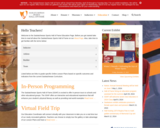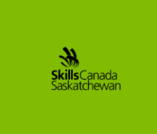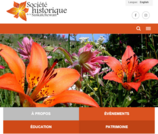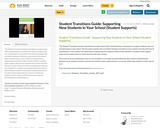
Come and learn all about sport in Saskatchewan. Virtual field trip options available.
- Subject:
- Health & Fitness
- Physical Education
- Material Type:
- Primary Source
- Date Added:
- 11/27/2020

Come and learn all about sport in Saskatchewan. Virtual field trip options available.

Saskatchewan Wildlife Federation offers a variety of programs for students and communities.
Check out what’s available:
NASP (National Archery in the Schools Program)
Geocaching
Backyard Biodiversity Challenge
Youth Conservation Leadership Initiative
BigFOOT Snowshoe loan
Wildlife Posters
Borrowing GPS units
Fish Artwork Contest – Grades 4-6
Classrooms on Ice / Classrooms in the Marsh
Fish in Schools (FINS)
Printable Fisheries Colouring & Activity Book
Classroom in a box – Bird Species of Saskatchewan
Classroom in a box – Fish Species of Saskatchewan
Classroom in a box – Magnificent Mammals of Saskatchewan
Species at Risk – A Guide to Canada’s species at risk in the Prairie Provinces

"Skills Canada Saskatchewan is a not-for-profit Provincial Organization that promotes skilled trades and technologies to young people in Saskatchewan."
This site has a wealth of information about skills and tech and the trades in SK.
*Skills for success - learn about the skills you need for success - videos
*Skills competitions - find skills competitions
*Skills Profiles - learn about construction, employment, IT, manufacturing & engineering, services and transportation skills
*Programs - trade & tech days, National Skilled Trade and Tech Week

La plus ancienne des associations provinciales de services est la Société historique de la Saskatchewan. C’est en automne 1977 qu’on lance l’idée de créer une Société historique fransaskoise, dont les buts seront: «grouper les personnes intéressées à notre histoire; développer le goût de notre histoire et communiquer par des écrits la connaissance de notre histoire; recueillir et déposer aux archives provinciales les souvenirs, portraits, gravures, documents, papiers de familles, etc..».

"The Student Transitions Guide is intended to provide school staff in Saskatchewan a framework to support students who are transitioning to a new school. This document explains the correlation between transition to new schools and reduced levels of achievement. It also outlines the importance of supporting new students, helps schools identify if a student needs support, what may be required and an action plan that will assist schools.
There may be local considerations that are not included. It is strongly recommended that each school in Saskatchewan develop a local student transition protocol to provide the best opportunity for success for all the new students in their school." (p.2)
From the Government of Saskatchewan at saskatchewan.ca

Pow-wow to the First Nations people of Saskatchewan is a way of life and a symbol of cultural survival. There are more Pow-wows here in Saskatchewan on an annual basis than any other province or state in North America. Saskatchewan Pow-wows can be labeled as the best in North America as the dancers and drum groups are proven champions throughout North America. This dance form is traced to the Omaha and Pawnee people of the southern United States and came north through the Dakota people.
This site gives background knowledge on the history of Pow-wows and describes contemporary Pow-wows. It outlines different dance styles and regalia.
From University of Saskatchewan Archives.

Tourism Saskatchewan vetted resources on planning a Saskatchewan vacation.

Treaty Education
Outcomes and Indicators
Saskatchewan Ministry of Education
2013

This is a great field trip for your grade 5 class. Tours include, Chicago Connection, Passage to Fortune, and Bunker 24. This field trip aligns well to the topic of immigration.

"The Common Framework of Reference (CFR) is a criterion-referenced performance scale that supports educators as they work with a growing demographic of learners that require English as an Additional Language (EAL) supports. In order to ensure that such learners attain high levels of achievement across the Saskatchewan curriculum, the use of reference scales and corresponding resources is valuable to teacher planning and development of:
effective strategies to support English language learners; consistent approaches to instruction and assessment based on language needs; and, ongoing monitoring of student progress over time.
The Common Framework of Reference (CFR) is a well-established language framework that identifies ways in which learners at various levels of proficiency use language to perform meaningful, authentic tasks. The descriptors within the CFR identify observable behaviours that can be structured to support the attainment of provincial curriculum outcomes for EAL learners." (p.1)
The following document is from the Government of Saskatchewan and it addresses elementary, middle and secondary learners.

This series is a charming and often humorous look at the contemporary life of a Cree community. Set in a fictitious community in northern Saskatchewan, the animation stories follow the exploits of young Raven, Talon and their cousin T-Bear as they face challenges and learn valuable life lessons.
Educators can use the series to teach children about Cree culture and about universal themes such as honouring tradition, cooperation, self-esteem and ethics. This series is also available in French and Cree versions.

This series is a charming and often humorous look at the contemporary life of a Cree community. Set in a fictitious community in northern Saskatchewan, the animation stories follow the exploits of young Raven, Talon and their cousin T-Bear as they face challenges and learn valuable life lessons.
Educators can use the series to teach children about Cree culture and about universal themes such as honouring tradition, cooperation, self-esteem and ethics. This series is also available in English and French versions.

On August 9, 2016, a young Cree man named Colten Boushie died from a gunshot to the back of his head after entering Gerald Stanley’s rural property with his friends. The jury’s subsequent acquittal of Stanley captured international attention, raising questions about racism embedded within Canada’s legal system and propelling Colten’s family to national and international stages in their pursuit of justice. Sensitively directed by Tasha Hubbard, nîpawistamâsowin: We Will Stand Up weaves a profound narrative encompassing the filmmaker’s own adoption, the stark history of colonialism on the Prairies, and a vision of a future where Indigenous children can live safely on their homelands.

The film and learning guide are suitable for middle-year and highschool students (Grades 7–12) and relevant to courses in Indigenous Studies, History, Social Studies, Anthropology, Political Science, Geography, English Language Arts, Journalism, Communications, Media Studies, Creative Writing, Health Sciences & Wellness, Psychology, Law, Sociology, and Career Education.

Mission - Heritage Saskatchewan gives voice to Living Heritage.
Vision - Heritage is a valued and dynamic legacy that contributes to our sense of identity, creates an understanding of our past, is used to build communities in the present, and informs our choices for the future.

Hear words from the book in nēhiyawēwin
These activity sheets are from the book “When the Trees Crackle with Cold: A Cree Seasons Activity Book” by Bernice Johnson-Laxdal and Miriam Körner. We thank them for their permission to share these activities with you for Family Literacy Day in Saskatchewan!
Story Questions
Read and Find Activity Sheets
Look and Find Activity Sheets